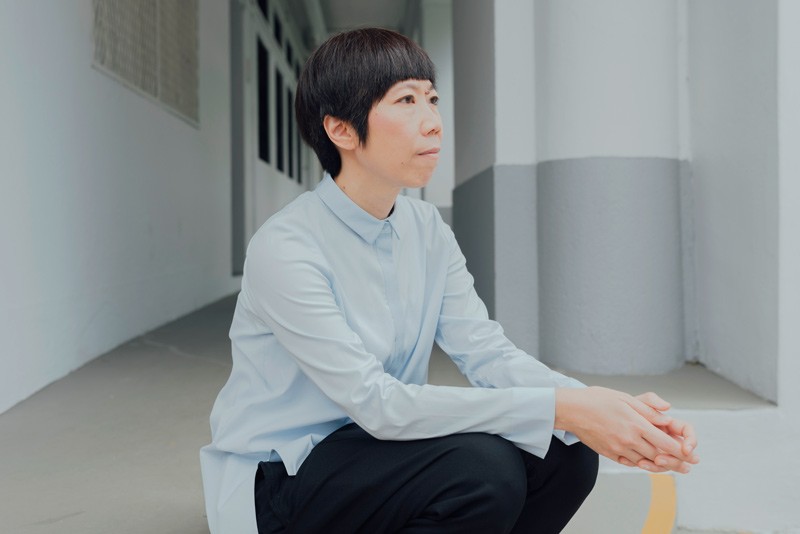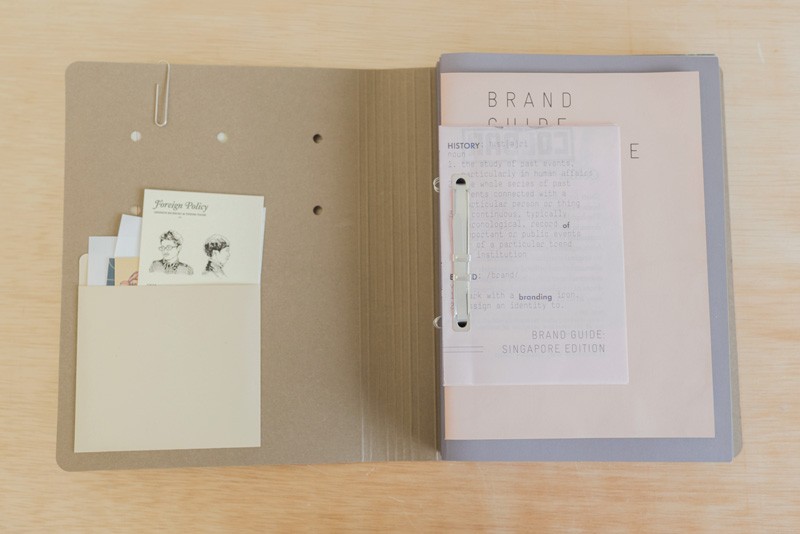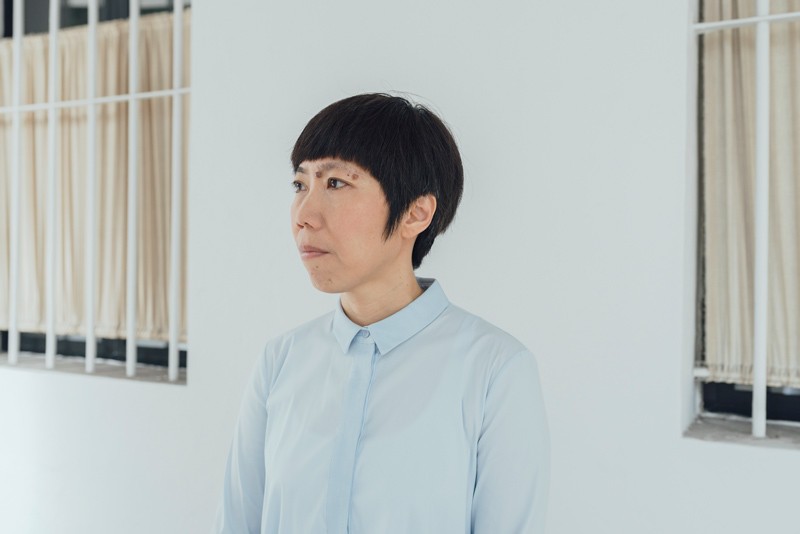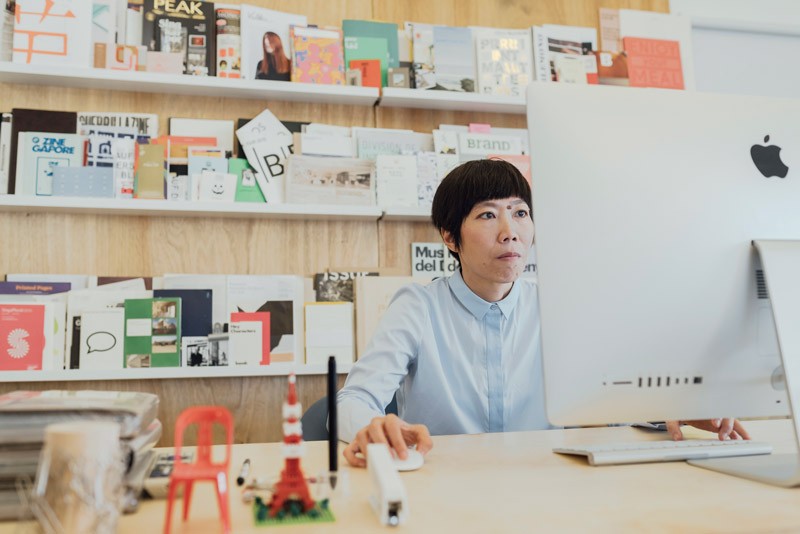When I was doing research on Yah-Leng Yu, I quickly became drawn to her facial structure. I knew she bore a certain semblance to someone—and it is the kind of face you would never forget. The name suddenly appeared in my mind. Rei Kawakubo—the founder and designer of Comme des Garçons—a highly regarded iconoclast in the world of fashion. We are in Yah-Leng’s office at 78 Yong Siak Street, and as she sits on the opposite side of the meeting room table, I study her visage carefully. Like Kawakubo, she has a steely gaze that borders on a slight thoughtfulness, and a delicate, petite figure. What I find most intriguing, is how she uses silence effectively. It’s certainly not disconcerting, at least to me, because I appreciate quiescent moments where I can truly appreciate a human being’s existence. I can almost hear her thoughts—while waiting for an opportune time to ask what she is wearing. “My shirt is from COS, the pants are Comme des Garçons, and my sneakers are Common Projects.” I raise a follow-up question: Is Comme des Garçons your favourite brand? “Yes, and Rei Kawakubo is one of my favourite designers. I like her philosophy and approach to design,” she says. “I love the way she deconstructs her clothes and puts them back together again. Her unconventional and innovative aesthetic is something I try to infuse into my work.” I nod, in the process of concealing a smile—my initial conceived Kawakubo connection has somehow manifested itself. At the moment, Yah-Leng leads a rather peripatetic lifestyle. Just last week, she was in Kuala Lumpur for a 5-day shoot, and this week, she is off to Bangkok. Although she is aware of her grinding work schedule, she feels blessed to be in her current position. “I enjoy my work. Hopefully, I am not tired of it because last year took quite a toll on me.” Her words sound genuine, but are couched with mild hints of fatigue. 2015 was a stellar year for the Foreign Policy Design Group after the successful completion of fêted projects such as Brand Guide: Singapore Edition, The Working Capitol and Gallery & Co. And I can only predict a continuation of her remarkable trail of brilliance in 2016.
A Candid Conversation with Yah-Leng Yu
WY-LENE YAP: I’m aware your daily routine involves reading at least one article from a magazine.
YAH-LENG YU: [laughs] Yeah, on the bed. . .
WY-LENE: What did you read today?
YAH-LENG: Today is not about design. It’s about Donald Trump.
WY-LENE: Are you following the U.S. elections?
YAH-LENG: Not as closely as I would like to—once in a while, I would turn on CNN.
WY-LENE: Who are you supporting?
YAH-LENG: I’m leaning more towards Hillary. Trump is entertaining, but he is kinda scary.
WY-LENE: Can you tell me about your first memory of design?
YAH-LENG: My very first memory of design was in secondary school. I was in the school band, and my drum major said that we needed to change our emblem including all the accompanying collaterals such as the badge, t-shirt, and band folder. Out of the many entries submitted, mine was chosen. It was a proud moment for me.
WY-LENE: Why did you choose to go to The Art Institute of Boston?
YAH-LENG: It’s a long story. My initial plan was to go to the Rhode Island School of Design. But back then, there wasn’t a wealth of information, and it was difficult to research on schools in the US. So I decided to go to Brenau University to take some foundation courses, and during my spring break, I took a train to Boston to visit my friends who were studying music there. Along the way, I stopped by New Haven, Connecticut because the Yale School of Art has a famous graphic design programme. I also checked out the Rhode Island School of Design, and somehow, there was an air of sadness, which made me quite depressed. It could be due to the fact that it was a suburban area, and there was no hustle and bustle. I visited New York too, and in the '90s, New York was gritty. There were vice and crime everywhere, and I realised it was a very tough city to live in. Boston, however, was different. I don’t think my friends influenced me. I saw students sitting on the campus lawn, and they were reading, chilling. . . I felt inspired and a sense of belonging immediately because I wanted to be part of an intellectual group of young people who were seeking an education. Furthermore, the Arts and Music schools in Boston have a special agreement whereby students could take classes from different schools. For example, if you were a music student, you could take a sculpting course in the summer. I really liked that arrangement, which was why I went to The Art Institute of Boston.
WY-LENE: How did your working experiences in New York shape your professional growth?
YAH-LENG: My first freelance gig was designing posters and collaterals for Hollywood movies in LA. It was super commercial. I didn’t like LA—the people were superficial, so I decided to go to the East Coast. In New York, I worked for a small design company, and we did a lot of annual reports and educational books. It was a team of 5, and I learnt a lot from my boss because he was really hands-on. Sometimes he would even let me run the show. I also worked for another company called DigitalForm, and my bosses were Persian royalties who were asylum seekers from Iran. They are extremely smart since they were educated at Brown and Harvard. During that time, dot-com was big, so we focused on building an e-commerce website for fashion brands since the bosses had a lot of connections with the European brand owners. What made the company interesting was how diverse all my colleagues were—we had an international team. Although the company eventually closed down, at least 6 or 7 of us came out to start our own businesses.
WY-LENE: I understand that you pride yourself as an idea maker and storyteller. What’s your best story?
YAH-LENG: I think being able to tell the story of Singapore with our Brand Guide. Singapore is always not known for design or creativity, and now we are able to showcase that to the world. Hopefully, people’s perception will change because we do have a creative community. In addition, we have places to hang out at, good food to eat, and cool places to shop at.
WY-LENE: Would you consider Brand Guide your best idea then?
YAH-LENG: I don’t know, but I hope there will be better ideas down the line. [laughs] So far, I am quite happy with the results and feedback has been great too.
The Singapore government could use the Brand Guide as a report card to show how innovative local brands are.
WY-LENE: You got covered by Wired! That’s pretty major. How much do you think that idea is worth?
YAH-LENG: In terms of money? [laughs] I think we haven’t milked it enough. The Singapore government could use the Brand Guide as a report card to show how innovative local brands are. I know the government has been trying to cultivate the creative industry for many years, and the aim is to make Singapore the next design hub. We have design courses, initiatives such as DesignSingapore, and most recently, Singapore has just been named Creative City of Design by UNESCO.
WY-LENE: How many copies have you sold?
YAH-LENG: We printed 3,000 copies and probably have less than 500 left.
WY-LENE: Are you planning to produce more?
YAH-LENG: We are thinking of working on other city editions. It’s definitely not going to be easy, as we need to find someone to partner with us. But we are speaking to a few interested people at the moment to see if it is feasible, and whether we have the resources to finance the next phase.
WY-LENE: What are your top cities?
YAH-LENG: I definitely want to do New York, Tokyo and London.
WY-LENE: How long did it take to make the guide?
YAH-LENG: Oh my god. . . one year. The idea came about when I was travelling, and I thought to myself: Hey, all these books are so frivolous. They are just showing pictures, and I don’t know even know what they are trying to do. I mean, they are nice… but what’s the idea behind it? Who is the designer? We have so many wonderful things happening in Singapore, and certain brands are doing very well. So interviewing the brand owners, asking them about their inspiration, and even shooting their collaterals made sense. However, the idea was put on hold for a while because we were really busy. Six to nine months later, we compiled a long list of brand owners, but we had to trim it down.
WY-LENE: What were the criteria used to select the 17 brand owners?
YAH-LENG: They must have a good-looking brand that hits the design mark.
WY-LENE: Isn’t that kind of subjective?
YAH-LENG: We definitely had our own yardstick. That aside, the brand owners were required to have a successful and sustainable business. It can’t open for one year, and close down the next. Lastly, the brand owners have to be people who are willing to take risks, disrupt their industry, and do things differently. Unfortunately, we couldn’t get some of the brand owners because they were too busy or uncontactable.
WY-LENE: Who did you really want to bring onboard, but couldn’t?
YAH-LENG: COMO. I know Christina Ong has been around for a long time, yet everything she does is very relevant. I have been to their resorts before and I always leave very impressed.
WY-LENE: How does one build a strong brand?
YAH-LENG: The brand owner has to be a visionary. And he or she is someone who takes ‘the road less travelled’. There are a lot of examples in the Brand Guide, and they know the mark they want to leave on the world.
WY-LENE: It’s been 9 years since you started Foreign Policy Design Group. How has the journey been so far?
YAH-LENG: During the first two years after coming back from New York, we were focused on wrapping up all our existing projects that we had there. Back home, I did feel like a fish out of the water because I did not know anyone in the industry. So, we started to lay our roots and even familiarised ourselves with GeBIZ. It definitely took us some time to understand the design culture in Singapore. There was also a learning curve working with the printers here. . . even little things like paper swatches and samples. I am quite grateful to have met people like Chris Lee and Pann Lim who have been very helpful in terms of dishing out advice.
WY-LENE: What does the future hold for your company?
YAH-LENG: We are a company that constantly innovates. We started out as a graphic design studio, but now we also provide branding services, product design and even interactive design. Branding doesn’t stop at a set of business cards and letterheads—it’s about extending the brand experience, and that involves telling a story to reach out to a wider audience. It’s crucial to be involved in all the necessary touchpoints, so the message is clearer and more consistent—and that’s what we do.
WY-LENE: What is your creative process?
YAH-LENG: The most important thing is having a conversation with the client. We have a discovery process where we sit down and understand what the client needs. During that time, we also learn about their industry. For us, we like to be able to provide our own perspective—what can we do for our client to make their product better and take things to the next level? That’s our strength, which is why clients come to us.
WY-LENE: Were there times when you disagreed with a client’s direction, and you managed to convince them to go with yours instead?
YAH-LENG: Yes, many times. [laughs]
We usually don’t take directions from our clients.
WY-LENE: If you’re given strict parameters to design something, will that stifle your creativity?
YAH-LENG: We usually don’t take directions from our clients. We put forth our ideas and perspective in a way that is in-line with their business. Sometimes, the client is very driven by the operations side, but what if they look at it from a consumer’s point of view? It’s possible to do things differently. And if the client is open-minded, the end result always turns out well.
WY-LENE: How do you stay relevant?
YAH-LENG: That’s a difficult question. I am a very curious person and I try to know what is happening around me. I like to check out new places, so I travel a lot too.
WY-LENE: Where was the last place you travelled to?
YAH-LENG: Central Europe: Slovakia, Slovenia, and Croatia. When my partner [Arthur Chin] and I were driving in Croatia, we noticed how medieval the city was, people were chopping wood for their houses, and even their restaurant menu is in 5 different languages.
WY-LENE: How many projects are you working on at the moment?
YAH-LENG: Seven. 2015 was a busy year—we were swamped with Brand Guide, The Working Capitol and Gallery & Co, so we are trying to take it easy.
WY-LENE: Why is Loh Lik Peng your favourite client?
YAH-LENG: He knows the kind of brand he wants to build. He works with good designers and trusts their work. For example. when we design something for him, as long as it meets his criteria, he goes with our recommendations and taste. He doesn’t nitpick on details like: Why are you using green? Or why is this font sans-serif? He knows by doing that, he is wasting everyone’s time—it’s counterproductive.
Design is an art form because when you design something, you are planning a shape, or a layout, or a texture formation.
WY-LENE: Is design an art form?
YAH-LENG: It’s a debatable statement. People don’t normally see design as art, but design is an art form because when you design something, you are planning a shape, or a layout, or a texture formation. When I lay out a page, I look at it like an art piece. There has to be balance. For example, a small paragraph has to balance with a bolder font if you’re highlighting a particular phrase.
WY-LENE: Is having too much white space a bad thing?
YAH-LENG: Not really. You need to breathe. I like to look at it in totality: Is it too heavy on the eyes? And are there breathing spaces?
WY-LENE: I know you love typography. What is your favourite font?
YAH-LENG: Bodoni.
WY-LENE: What is the hardest part about your job?
YAH-LENG: Making design decisions. If I don’t make a quick decision, things will be held up. But sometimes, I want to mull over it, and look at it from a macro perspective—especially if it is a big project involving many different components.
WY-LENE: You need time to declutter your brain in order to have a holistic approach.
YAH-LENG: Exactly. If you single each component out, they might look great as a standalone. But as a whole, they might clash.
WY-LENE: How long do you take to make a decision then?
YAH-LENG: 1 or 2 days. . . but it could take up to a week too.
WY-LENE: How is your hiring process like?
YAH-LENG: We hire people who will work well with the rest of the team. Someone who doesn’t have a chip on his shoulder, and is willing to learn. You would be surprised how people come in with a fixed way of doing things, and that’s kinda scary because we want people to be innovative and adaptable to change. We have projects from different industries, so you can’t apply the same approach to every single one of them. We get applicants who say, “I want to work with you and learn from you.” But I question if they will be able to contribute to the company in terms of their talents and skills. . . because that’s a fair exchange right?
WY-LENE: What has been the biggest challenge working with your husband [Arthur Chin]?
YAH-LENG: We keep our roles pretty separate. He takes charge of strategy and the business, while I handle the creative side. Even when there are conflicts or disagreements, we resolve them quickly because at the end of the day, I make the final creative decision.
WY-LENE: What is the secret to balancing marriage and business in your relationship?
YAH-LENG: Having open communication. We keep our relationship really professional. It’s only in the last 2 years people know we are married.
WY-LENE: What is your greatest weakness?
YAH-LENG: Procrastination. [laughs]
WY-LENE: What is your most marked characteristic?
YAH-LENG: I can forecast fashion trends very well, and I apply that into our designs.
WY-LENE: What is the trait you most deplore in others?
YAH-LENG: Dishonesty.
WY-LENE: Finally, what gives you the most satisfaction in life?
YAH-LENG: Doing the things I love to do. I feel blessed to be in my current position because I enjoy my work. Hopefully, I am not tired of it because last year took quite a toll on me. [laughs]





